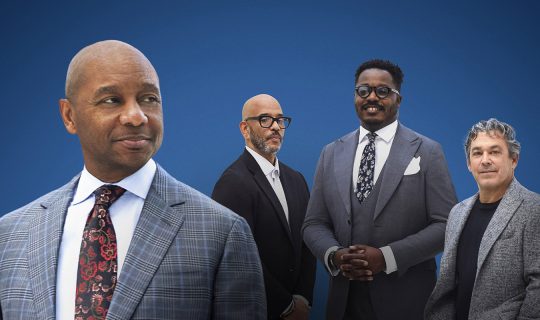February 8, 2013
For sax poet Joe Lovano, the 2000s was a decade of variety. He was at the Village Vanguard with a horn-heavy nonet; at Dizzy’s Club Coca-Cola in a duo with pianist Hank Jones; in Germany with a big band and orchestra; and in four different trios, all on the same album. That ten-year stretch also saw him recording as a leader for just one label: Blue Note. On a recent winter morning, we conversed with Lovano about five of his albums released between 2000 and 2008.
52nd Street Themes (2000)
Lovano kicked off the 2000s with the dense but agile debut from his nonet. Heavy on the compositions of Tadd Dameron, the music on 52nd Street Themes was orchestrated by the late Cleveland alto saxophonist Willie “Face” Smith. “Nineteen seventy-five or so, Willie and I both played with Brother Jack McDuff in Cleveland,” remembers Lovano. “[McDuff] was touring with a band with two tenors, and he added a baritone and an alto in each town that he was going. So I got the call to play baritone. Willie played alto. So we played that week together, [which] subsequently led to us going on the road with McDuff for that year. So I was on the road with Willie, and during the time we were on the road, he was writing four-saxophone arrangements for McDuff. I mean, in the back seat of the car. Would write out, like, ‘Moody’s Mood for Love.’”
Tucked in among the pieces powered by five saxophones, one trumpet, one trombone, and a piano trio is “Abstractions on 52nd Street,” a contemplative solo saxophone soliloquy from Lovano that prefaces the nonet’s take on Thelonious Monk’s “52nd Street Theme.” Though it sounds completely spontaneous, “Abstractions” is partially scripted. “I wanted to put an improvisation in front of [‘52nd Street Theme’], but I wanted it to be a little more specific, so I wrote out an improvisation that I played with interpretation,” explains Lovano. “So each time I played this beginning, I would reflect on things I wrote. Instead of just playing off the top of my head. I was focusing on some written material, yet playing with total interpretation of it. And that kinda became a separate piece.”
Flights of Fancy: Trio Fascination, Edition Two (2001)
In 1998, Lovano cooked up Trio Fascination, Edition One, a spacious conversation with bassist Dave Holland and drummer Elvin Jones. For its sequel, Flights of Fancy, the saxophonist took things a step further by recording with four different threesomes, one of which included drummer Joey Baron and saxophonist Billy Drewes. “Playing with Joey Baron and Billy Drewes as a trio goes back to when we were in Boston together in the mid ’70s,” says Lovano. “We were up there going to Berklee College of Music, and living in Boston, and playing together. A lot. And on occasion, played trio! We had a loft space in Allston, Massachusetts, outside of Boston, and we could play into the early mornings. And had a lot of jam sessions and a lot of collaborations with folks. And Joey and Billy and I played together back then. There was a lot of magic in our approach together. So I brought that trio in on it.”
One of the high points of Fancy is a tender take on Wayne Shorter’s “Infant Eyes” birthed by pianist Kenny Werner, harmonica hero Toots Thielemans, and Lovano on tenor. “It was just a haunting melody to hang on with Toots,” recalls Lovano. “To play tenor saxophone and harmonica together. And let Kenny kind of just color around us. When we were playing it, and making that take, I was getting the chills. Just the way we were holding notes together. And breathing together as one.”
I’m All for You: Ballad Songbook (2004)
Lovano slowed the pace on 2004’s I’m All for You, a collection of ballads brewed with bassist George Mraz, drummer Paul Motian, and pianist Hank Jones. One of the first musicians to recognize that Lovano knew his way around a slow jam was the saxophonist, clarinetist, and vocalist Woody Herman. “I was twenty-three when I joined [Herman’s] band in 1976,” says Lovano. “When I played the first time on ‘Easy Living,’ Woody heard something in my playing that he wanted to hear more of. I got that sensation from him. That felt really good. ’Cause then he focused on my playing and featured me in a lot of different ways throughout the almost three years I played with the band. So even at that young age, I had a certain affinity and love for playing on a ballad.”
The lone original on I’m All for You is the album-opening title track. Its chords might ring a bell, though. “‘I’m All for You’ is based on ‘Body and Soul,’” says Lovano. “The harmonic sequence of ‘Body and Soul.’ But I had recorded ‘Body and Soul’ on From the Soul, with Michel Petrucciani in a duet. And they don’t really encourage you to record the same tune on another record. On Blue Note or any other label. They want you to explore different material. But I had to play on that sequence of harmonies with Hank. Hank played ‘Body and Soul’ with Coleman Hawkins and Lester Young and Ben [Webster]. Had played that tune his whole life. So I decided to write a different theme.”
Kids: Live at Dizzy’s Club Coca-Cola (2007)
In preparation for the recording of I’m All for You, Jones and Lovano paired off to go over tunes. The partnership felt so good that they would later do duo dates, including a night at New York’s Dizzy’s Club Coca-Cola when the tapes were rolling. “Everything,” answers Lovano matter-of-factly when asked what made Jones’s playing special. “His touch. His feeling. His expression. His harmonic searching. He’s not a repeater. He’s a complete flowing improviser.”
The bluesy, uplifting “Kids are Pretty People” was written by Jones’s trumpeter brother, Thad. Hank was unfamiliar with it before working with Lovano. “‘Kids are Pretty People’ was a tune of Thad’s that Hank had never played,” remembers Lovano. “He loved Thad’s music and thought Thad was a genius. Every time we played any of Thad’s tunes, Hank’s eyes would get wide open. The look on his face was like he couldn’t believe his brother wrote this tune. [laughs] There was a lot of love in Hank’s expression with music in general. And playing Thad’s music was really close to him.”
Symphonica (2008)
Symphonica teams Lovano with a gargantuan ensemble from Cologne, Germany: the WDR Big Band plus the Rundfunk Orchestra. Arranged and conducted by pianist Michael Abene, the album reimagines a half-dozen pieces by Lovano and Charles Mingus’s “Duke Ellington’s Sound of Love.” “You have to relax and meditate into the surrounding atmosphere,” explains Lovano about approaching a situation as large as Symphonica. “For me, you have to play from a peaceful place and try to feel like you’re a part of this massive sound and energy. To not try to play over it. But to play within it.”
First heard on Friendly Fire, the 1999 collaboration between Lovano and alto saxophonist Greg Osby, “Alexander the Great” started life as a bustling, Ornette Coleman-esque swinger. But in the hands of Abene, the big band, and the orchestra, it’s an epic, colossal spy-movie score, with Lovano’s blazing tenor at the center. “Based on the harmonic sequence of ‘Bye Bye Blackbird,’” remembers Lovano about the origins of “Alexander the Great.” “Which is a tune I love to play, and I learned how to play it listening to Miles Davis’s version of it from his ’Round About Midnight record with John Coltrane. I was flying to Japan. The Quartets record had just come out, with Tom Harrell. But Tim Hagans came to Japan with me. And we did a quartet tour. And I wrote that tune on the flight over. All of a sudden, I just heard this melody over those harmonies. I wrote it out on the flight over and we started to play it.”
Photos courtesy of Jimmy Katz




